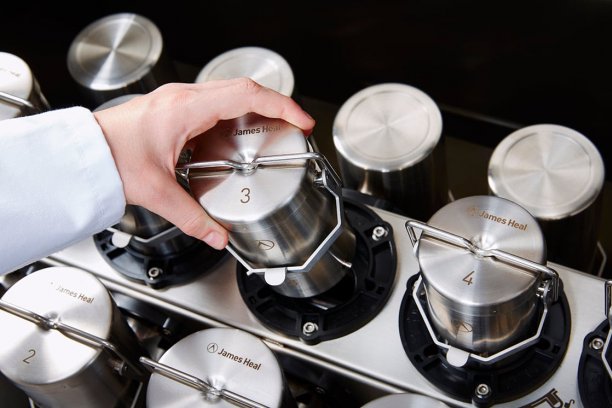
SGS expanding testing for fibre fragmentation
Gyrowash assists in measuring microfibres released from simulated domestic laundering

6th November 2023
Innovation in Textiles
|
London
The Microfibre Consortium (TMC) has teamed up with specialist test instrument manufacturer James Heal to hold the first public demonstration of a test method for fibre fragmentation from fabrics.
The event took place during the Textile Exchange Conference (October 23-27), when delegates embarked on a field trip to King’s College, London, where they were shown the TMC test method in action.
It utilises James Heal’s Gyrowash to assist in measuring microfibres released from simulated domestic laundering.
The TMC test method was developed through a collaborative relationship between University of Leeds, the European Outdoor Group and TMC, as well as a larger stakeholder network, following many rounds of testing and validation within the industry.
PhD student Alice Hazlehurst, a researcher at The University of Leeds, who worked on an award-winning paper Quantification of microfibre release from textiles during domestic laundering, published in January 2023, demonstrated the TMC test method for over 40 delegates who were keen to learn more about fibre fragmentation testing and measurement.
Fibre fragmentation refers to the process where small quantities of fibres, often referred to as microfibres, are lost from textiles at various stages of a product’s lifecycle. Many tons of tiny fibres from natural and manmade textile sources, such as cotton and polyester, are released from washing machines into the environment each year. These microfibres enter the environment through a number of pathways, such as through wastewater, soil and air.
Microfibres have a persistent nature and while their impacts are not yet fully understood, evidence is growing. Due to their shape and/or added chemicals, fibre fragments can cause harm when ingested by organisms, and have been found in humans. Academics from the UK’s IMPACT+ Network, led by Northumbria University, shared with delegates how the environmental impact of microfibres goes under the radar as they are not currently considered in any life cycle assessments.
Created originally for testing colour fastness in laundering fabrics and leather, the James Heal GyroWash was used in controlled laboratory testing throughout the research that led to the final TMC test method. This instrument is used in textile testing laboratories worldwide.
“We hope it will make a difference in helping the textile industry to recognise and reduce its impact on environmental pollution through relevant testing,” said Helen Warburton, technical textiles specialist at James Heal.
“ It was fantastic to see so many delegates at the Textile Exchange Conference 2023 actively engaged in the topic of fibre fragmentation,” added TMC research director Kelly Sheridan. “The Microfibre Consortium bridges the gap between academia and the industry. It is only through such science-led, industry aligned action that together we will be able to combat microfibre pollution to the environment.”
A short video summary of the event is available to view here...

Business intelligence for the fibre, textiles and apparel industries: technologies, innovations, markets, investments, trade policy, sourcing, strategy...
Find out more